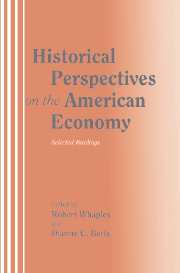Book contents
- Frontmatter
- Contents
- Acknowledgments
- Introduction to students
- Introduction to instructors
- Contributors
- I Introduction
- II Colonial and early national economy
- III Slavery and servitude
- 4 “The rise and fall of indentured servitude in the Americas: An economic analysis”
- 5 “The anatomy of exploitation”
- 6 “Slavery: The progressive institution?”
- 7 “Explaining the relative efficiency of slave agriculture in the antebellum South”
- IV The South since the Civil War
- V The rise of American industrial might
- VI Populism
- VII Women in the economy
- VIII The Great Depression
- Appendix: Basics of regression
- Glossary
- Name index
- Subject index
4 - “The rise and fall of indentured servitude in the Americas: An economic analysis”
Published online by Cambridge University Press: 05 June 2012
- Frontmatter
- Contents
- Acknowledgments
- Introduction to students
- Introduction to instructors
- Contributors
- I Introduction
- II Colonial and early national economy
- III Slavery and servitude
- 4 “The rise and fall of indentured servitude in the Americas: An economic analysis”
- 5 “The anatomy of exploitation”
- 6 “Slavery: The progressive institution?”
- 7 “Explaining the relative efficiency of slave agriculture in the antebellum South”
- IV The South since the Civil War
- V The rise of American industrial might
- VI Populism
- VII Women in the economy
- VIII The Great Depression
- Appendix: Basics of regression
- Glossary
- Name index
- Subject index
Summary
Indentured servitude appeared in Virginia by 1620. Initially a device used to transport European workers to the New World, over time servitude dwindled as black slavery grew in importance in the British colonies. Indentured servitude reappeared in the Americas in the mid-nineteenth century as a means of transporting Asians to the Caribbean sugar islands and South America following the abolition of slavery. Servitude then remained in legal use until its abolition in 1917. This paper provides an economic analysis of the innovation of indentured servitude, describes the economic forces that caused its decline and disappearance from the British colonies, and considers why indentured servitude was revived for migration to the West Indies during the time of the great free migration of Europeans to the Americas.
Indentured servitude appeared in use in Virginia by 1620, little more than a decade after the initial British settlement of North America at Jamestown. Servitude became a central institution in the economy and society of many parts of colonial British America; a leading historian of indentured servitude in the colonial period, Abbot Emerson Smith, estimated that between one-half and two-thirds of all white immigrants to the British colonies between the Puritan migration of the 1630s and the Revolution came under indenture. Although it dwindled in importance over time, servitude continued to exist in mainland North America until at least the fourth decade of the nineteenth century.
- Type
- Chapter
- Information
- Historical Perspectives on the American EconomySelected Readings, pp. 110 - 140Publisher: Cambridge University PressPrint publication year: 1995



